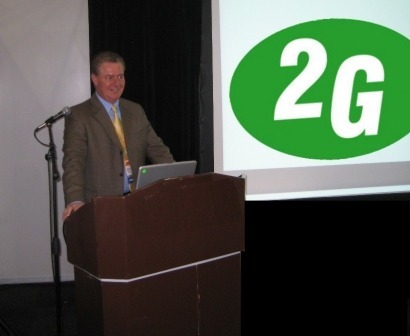
As the world returned to work after the Christmas break, Renewable Energy Magazine talked to Michael J. Turwitt about 2G-Cenergy’s goals for the future, and how the US will play a significant part in his business.
2G-Cenergy supplies decentralised energy technology and bioenergy solutions for electricity and heat generation, and is the United States and South American headquarter of 2G Bio-Energy Technology Corporation (2G Bio-Energietechnik AG): one of the largest MAN, MWM, and Jenbacher OEM manufacturers specialised in Combined Heat and Power (CHP) systems.
Turwitt explains that while his company’s CHP systems can run on a variety of fuels, biogas represents a very important segment for its business in America. Nonetheless, he likens the US biogas market right now to where Germany was in the 80’s. “The US is clearly approximately 20 years behind, but the biogas market is picking up and developing in the right direction. The potential is enormous, and we will see a fast development here, very similar to what happened in Central Europe during the past 15 years,” he predicts.
50% of electrcity through biogas possible
To achieve this, Turwitt urges the US to follow Germany’s lead, which he confidently believes has all the potential to provide 50% of its electricity using biogas in the future, and 25% by 2020.
However, he warns that conditions in the US are not so conducive to market growth as in Europe. “In most US States we don’t have high FiT’s (feed-in tariffs) that guarantee easy income for the plant operators... Therefore it is of even greater importance to utilise the most efficient and reliable technologies to reduce risk and to make projects work,” he says, adding that there are currently no American-made biogas CHP technologies that are of equal quality, durability, and providing high efficiencies as those in Germany. “Consequently it made a lot of sense to us to introduce 2G’s advanced CHP systems to the North American market,” he reveals.
Legislative change is also needed to support biogas, Turwitt warns. Individual States have made decisions to move forward, including the introduction of FiTs and incentives for CHP cogeneration, he says, but now the US needs a new and modern energy law.
While Turwitt stresses that the current legislative framework in the States dictates that a lot of biogas projects are based on municipal organic waste in order to make them financially viable, with the number of livestock on US farms running into the hundreds of millions, cofermentation using various mixed organic feedstock is well on its way. “Farm anaerobic digestion, especially dairy farm biogas facilities, will increase drastically... The potential is endless,” he adds.
With such opportunities ahead, it is no wonder that one of 2G-Cenergy’s main objectives is to build an even stronger foundation to support its leadership position in the US market during 2011.
To read the interview with Michael Turwitt, please click here:

